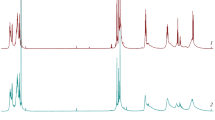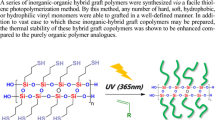Abstract
The synthesis of hybrid oligomers for photopolymer compositions was carried out based on the thiol-ene reaction between the tetraacrylate dihydroxydiphenylsulfide derivative and thiol-siloxane oligomer. Thiol-siloxane oligomer was synthesized by condensation of diphenylsilanediol and 3-(mercaptopropyl)-trimethoxysilane. The thiol-siloxane oligomer structure was identified by 1H, 13C, 29Si NMR spectroscopy including COSY, HSQC, and HMBC methods and by MALDI-TOF mass spectrometry. The hybrid oligomers were obtained at different tetraacrylate:thiol-siloxane oligomer ratios (1:2, 1:1, 2:1). The obtained compositions are resistant to the oxygen inhibition of photopolymerization and give flexible, thermostable, and rigid polymer films under UV light at air atmosphere. The degree of the film photopolymerization was monitored by IR spectroscopy. The thermomechanical properties of photopolymer films were determined using thermogravimetric, differential scanning calorimetric, and dynamic mechanical analyses. The storage modulus (E′) at room temperature (1.16–1.88 GPa) and the glass transition temperatures (78–133 °C) were determined for photopolymer films obtained at different ratios of acrylate and thiol-siloxane units. The photocured hybrid films exhibit high stability to thermal decomposition in the inert (T 10% over 321 °C) and oxidizing (T 10% over 314 °C) atmospheres.












Similar content being viewed by others
References
Sanchez C, Rozes L, Ribot F, Laberty-Robert C, Grosso D, Sassoye C, Boissiere C, Nicole L (2010) “Chimie douce”: a land of opportunities for the designed construction of functional inorganic and hybrid organic-inorganic nanomaterials. C R Chim 13:3–39
Malashkevich GE, Poddeneznyi EN, Mel’nichenko IM, Prokopenko VB, Dem’yanenko DV (1998) Luminescence-spectrum and strength properties of rhodamine 6G-doped silica gel films. Phys Solid State 40:427–431
Kim JS, Yang SCh, Park HJ, Bae BS (2011) Photo-curable siloxane hybrid material fabricated by a thiol–ene reaction of sol–gel synthesized oligosiloxanes. Chem Commun 47:6051–6053. doi:10.1039/c1cc11297j
Wheeler PA, Brungs M, Atkins GR (2003) Reduction of entrained hydroxy species in ormosil films for integrated optics. J Sol Gel Sci Technol 27:321–326
Trejo-Valdez M, Jenouvrier P, Fick J, Langlet M (2004) Characterization of optically active and photocurable ORMOSIL thin films deposited using the Aerosol process. J Mater Sci 39:2801–2810. doi:10.1023/B:JMSC.0000021457.85382.1c
Decker C, Zahouily K, Keller L, Benfarhi S, Bendaikha T, Baron J (2002) Ultrafast synthesis of bentonite-acrylate nanocomposite materials by UV-radiation curing. J Mater Sci 37:4831–4838. doi:10.1023/A:1020818414927
Hoyle CE, Lee TY, Roper T (2004) Thiol-enes: chemistry of the past with promise for the future. J Polym Sci Part A 42:5301–5338
Rydholm AE, Held NL, Benoit DS, Bowman CN, Anseth KS (2008) Modifying network chemistry in thiol-acrylate photopolymers through postpolymerization functionalization to control cell-material interactions. J Biomed Mater Res A 86:23–30
Mai TB, Tran TN, Rafiqul Islam Md, Park JM, Lim KT (2014) Covalent functionalization of silica nanoparticles with poly(N-isopropylacrylamide) employing thiol-ene chemistry and activator regenerated by electron transfer ATRP protocol. J Mater Sci 49:1519–1526. doi:10.1007/s10853-013-7833-4
Lenkova GA, Korolkov VP, Koronkevich VP, Nasyrov RK, Gutman AS, Iskakov IA, Treushnikov VM (2008) Diffractive-refractive intraocular lenses. Avtometry 44:75–88 [article in Russian]
Podkoscielna B, Worzakowska M (2010) Synthesis, characterization, and thermal properties of diacrylic/divinylbenzene copolymers. J Therm Anal Calorim 101:235–241
Loskutov VA, Shelkovnikov VV (2006) Synthesis of 2-ammonio(phosphonio)methyl-9-oxo-10-(4-heptyl-oxyphenyl)thioxanthenium bis[hexafluorophosphates(V)]. Russ J Org Chem 42:1097–1100
Fujiwara Y, Suzuki T, Nagai K, Tamura H, Ikuno H, Kami H (2008) Electrophotographic photoreceptor, and image forming method and apparatus using the same. Patent 0138725 USA, A1
Buestrich R, Kahlenberg F, Popall M, Dannberg P, Muller-Fiedler R, Rosch O (2001) ORMOCER(R)s for optical interconnection technology. J Sol Gel Sci Technol 20:181–186
Eo YJ, Lee TH, Kim SY, Kang JK, Han YS, Bae BS (2005) Synthesis and molecular structure analysis of nano-sized methacryl-grafted polysiloxane resin for fabrication of nano hybrid materials. J Polym Sci Part B 43:827–836
Silverstein RM, Webster FX, Kiemle D (2005) Spectrometric identification of organic compounds, 7th edn. Wiley, Mew York
Knunyants IL, Fokin AV (1950) Addition reaction to the acetylenic and diene hydrocarbons. Usp Khim 19:545
Hurd CD, Gershbein LL (1947) Reactions of mercaptans with acrylic and methacrylic derivatives. J Am Chem Soc 69:2328–2335
Studer K, Decker C, Beck E, Schwalm R (2003) Overcoming oxygen inhibition in UV-curing of acrylate coatings by carbon dioxide inerting, Part I. Prog Org Coat 48:92–100
Schreck KM, Leung D, Bowman CN (2011) Hybrid organic/inorganic thiol-ene-based photopolymerized networks. Macromolecules 44:7520–7529
Acknowledgements
The research was partly performed with the financial support from the RFBR (Project No 14-29-08134). Mass spectrometric works were performed with the financial support from the Russian Scientific Foundation (Grant No 14-14-00056).
Author information
Authors and Affiliations
Corresponding author
Electronic supplementary material
Below is the link to the electronic supplementary material.
Rights and permissions
About this article
Cite this article
Shelkovnikov, V.V., Ektova, L.V., Orlova, N.A. et al. Synthesis and thermomechanical properties of hybrid photopolymer films based on the thiol-siloxane and acrylate oligomers. J Mater Sci 50, 7544–7556 (2015). https://doi.org/10.1007/s10853-015-9265-9
Received:
Accepted:
Published:
Issue Date:
DOI: https://doi.org/10.1007/s10853-015-9265-9




